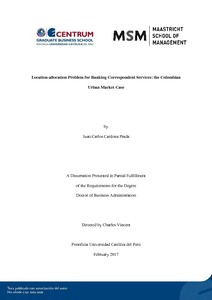Location-allocation problem for banking correspondent services : the colombian urban market case
Abstract
Banking correspondents are a channel through which third parties operate on behalf of a bank, under a contract authorising the provision of some banking services. This model has been implemented extensively in developing countries, as a channel to increase financial inclusion by bringing financial products and services closer to marginalised populations. However, there is a lack of studies on the criteria employed by banks when selecting retailers to turn into banking correspondents (BC), in turn preventing the channel from offering a service portfolio adequate to the capacities of the retailers providing this kind of services, affecting the profitability and sustainability of the channel. The current research parted from the agency theory, which allowed to understand the relationship between the parties involved in the delivery of BC services, seeking to boost financial inclusion in Colombia through the development of the BC channel by solving the problem of location and portfolio allocation for retailers acting as banking correspondents in Colombian urban zones. It parted from the case of Bogota, where improvements were achieved in the selection of retailers and portfolio allocation, thus enhancing the relationship between agents, allowing banks to select banking correspondents and allocating them a particular service portfolio, while transaction volumes and channel profits are maximised. This was done through the development of a methodology comprising five stages, namely: (a) the development of a taxonomy on network integration models and financial services; (b) the development of a taxonomy on the strategies of small and medium retailers that could be selected as banking correspondents; (c) the validation of both taxonomies through cluster analyses; (d) validation of the resulting classifications through an ANOVA and a Kruskal-Wallis H test; and (e) the elaboration of a chance-constrained programming model that uses the elements built and validated in the formers stages. A classification of retailers was obtained from factors related to their operational and business strategies, as well as a classification of banking correspondents based on their
service portfolios. It was also noted there is a significant relationship between the groups from both classifications, which led to the chance-constrained programming model being run on a sample of retailers in Bogotá, located at the borough of Suba. The model enabled to select those retailers best suited to become banking correspondents, determining the number of transactions according to their constraints in terms of retailer capabilities, banks and the environment, while estimating the expected income from these banking correspondent operations
Temas
Investigación cualitativa
Investigación cuantitativa
Investigación cuantitativa
Para optar el título de
Doctor en Administración Estratégica de Empresas
Collections
The following license files are associated with this item:






